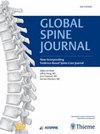非典型刽子手骨折:对 51 名 C2 非典型创伤性脊椎滑脱症患者的机构研究
IF 3
3区 医学
Q2 CLINICAL NEUROLOGY
引用次数: 0
摘要
研究设计回顾性队列研究.目的由于轴体后部皮质受累,非典型悬臂骨折与神经损伤风险增加有关。我们对 2010 年 1 月至 2023 年 9 月期间在一家一级创伤中心接受治疗的所有非典型悬臂骨折患者进行了回顾性分析。51名患者符合纳入标准,记录了人口统计学、治疗和放射学数据,并在I型和II型骨折组之间进行了比较。结果各组之间的最终治疗方式差异显著(P < 0.01),硬颈圈和侵入性晕固定分别是I型和II型骨折最普遍的治疗方法。一名 I 型骨折患者和四名 II 型骨折患者非手术治疗失败,需要进行手术治疗。在两组患者中,颈椎后路融合术(73%)是最常见的手术方法。两组骨折患者的中位住院时间差异显著(2.0(1.0-7.0)天 vs 5.0(3.0-8.0)天;P = 0.01)。无论骨折类型如何,住院时间较长与患者年龄增加(IRR = 1.02; P <0.01)、非白人种族(IRR = 2.47; P = 0.01)、MVC 损伤(IRR = 1.93; P <0.01)和存在非脊柱骨科损伤(IRR = 1.结论虽然不典型的 I 型绞索骨折可以通过硬颈圈进行有效的非手术治疗,但通过硬颈圈治疗的不典型 II 型骨折需要后续手术干预的风险更大。本文章由计算机程序翻译,如有差异,请以英文原文为准。
Atypical Hangman’s Fractures: An Institutional Study of 51 Patients With Atypical Traumatic Spondylolisthesis of C2
Study DesignRetrospective cohort study.ObjectivesAtypical hangman’s fractures are associated with increased risk for neurologic injury due to involvement of the posterior cortex of the axis body. We present the largest single-center cohort of atypical hangman’s fractures with the goal of guiding treatment decisions and outcomes based on fracture classification.MethodsWe performed a retrospective analysis of all patients with atypical hangman’s fractures treated at a single Level I trauma center between January 2010 and September 2023. 51 patients met inclusion criteria and demographic, treatment, and radiographic data were recorded and compared across the Type I and II fracture groups.ResultsFinal treatment modalities varied significantly between the groups ( P < 0.01), with hard cervical collar and invasive halo immobilization being the most prevalent treatments for fracture Types I and II respectively. One Type I fracture patient and four Type II fracture patients failed non-operative treatment, requiring surgery. Across both groups, posterior cervical fusion (73%) was the most common surgical approach. Median length of stay varied significantly between the two fracture groups (2.0 (1.0-7.0) vs 5.0 (3.0-8.0) days; P = 0.01). Irrespective of fracture type, longer hospital length of stay was associated with increased patient age (IRR = 1.02; P < 0.01), non-white race (IRR = 2.47; P = 0.01), injury caused by MVC (IRR = 1.93; P < 0.01), and the presence of non-spine orthopedic injuries (IRR = 1.72; P = 0.03).ConclusionsWhile atypical Type I hangman’s fractures may be managed effectively non-operatively with a hard cervical collar, atypical Type II fractures managed with a hard cervical collar are at greater risk of requiring subsequent surgical intervention.
求助全文
通过发布文献求助,成功后即可免费获取论文全文。
去求助
来源期刊

Global Spine Journal
Medicine-Surgery
CiteScore
6.20
自引率
8.30%
发文量
278
审稿时长
8 weeks
期刊介绍:
Global Spine Journal (GSJ) is the official scientific publication of AOSpine. A peer-reviewed, open access journal, devoted to the study and treatment of spinal disorders, including diagnosis, operative and non-operative treatment options, surgical techniques, and emerging research and clinical developments.GSJ is indexed in PubMedCentral, SCOPUS, and Emerging Sources Citation Index (ESCI).
 求助内容:
求助内容: 应助结果提醒方式:
应助结果提醒方式:


